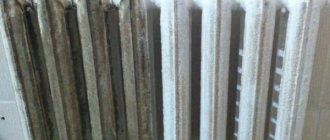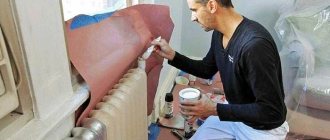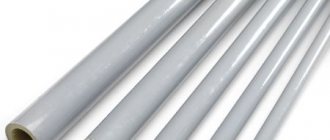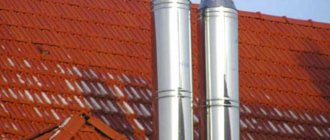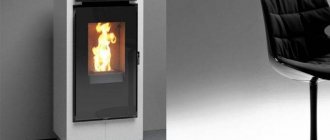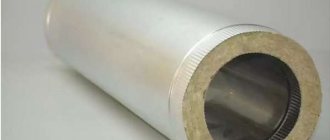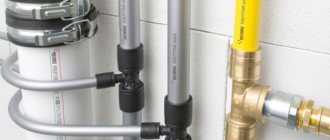Principle of choosing paint for pipes
Before we talk about how to properly paint heating pipes, it is necessary to determine the criteria for choosing the right composition suitable for such work.
In this case, it is important to consider the following requirements for the coloring composition:
- the material must withstand high temperatures (from 100°C and above);
- another important property that the composition must have is wear resistance;
- the toxicity of the painting mixture should be minimal;
- the paint must be resistant to aggressive environments.
Dye selection
Various types of coloring compounds can be used as a coating for polypropylene pipes, among which the following items stand out:
- standard paints used to protect metal surfaces;
- classic dyes intended for wall decoration;
- acrylic compositions, as well as mixtures designed specifically for plastic;
- polyurethane based dyes.
All of these types of coloring mixtures are commercially available and can be purchased at a hardware store.
Additional Information. When choosing a material suitable for painting polypropylene pipes, we advise you to contact the manager of a trade organization who will advise you on this issue.
When determining the coating application method for polypropylene, we proceed from the characteristics of the selected composition. Let's consider each of the options proposed above in more detail.
And radiators. Such a system is changed very rarely, but it is simply necessary to restore them to a decent appearance, especially since for steel pipes this is also a protective measure. Most often, enamel is used to paint radiators, but today a large number of different paints are produced that will allow you to do this work faster and with better quality.
An example of painted heating pipes. Paint for heating pipes must be chosen that is resistant to temperature influences.
In our article we will look at the need to paint heating equipment, the types of paints that are suitable for this, and the features of their application to system elements.
So why paint heating pipes? The answer is very simple, a layer of paint can protect the heating system from corrosion and give it a decorative appearance. In addition, the correctly chosen color increases the heat transfer of the heating system and brings the appearance of the pipes into line with the overall interior. Today, a large number of radiators are produced that no longer need painting, since they already have a protective layer, but pipes, even those made of plastic, still need to be painted.
Types of paint for heating pipes
When deciding what paint to paint heating pipes with, you should pay attention to the following types of compositions, which are most popular among consumers today:
- acrylic enamels
. This paint is based on organic solvents, which explains the not entirely pleasant smell when it dries. However, such a sample will provide a perfectly smooth and glossy surface and will last a very long time; - alkyd type enamels
. These compounds also emit an unpleasant odor, which may periodically appear in the future when the heating system is actively working. However, such paint will be very resistant to any mechanical damage and will not change its structure under the influence of high temperature. Do not forget that on the modern market there is a wide selection of shades of such enamel, so choosing an option suitable for a particular interior will not be difficult; you will only need to study the photos of samples provided by the manufacturer; - water-dispersion based paints
. Painting heating pipes with this composition is the most common option among consumers. This composition does not emit an unpleasant odor; in addition, this paint for hot heating pipes dries very quickly.
It is also impossible not to mention such an option as oil paint, which, however, is used extremely rarely today for painting pipes.
What and how to paint heating pipes is, of course, up to the consumer himself, however, in order for such work to go smoothly and without any difficulties, one should pay attention to a number of recommendations regarding surface preparation procedures before painting.
Preparation
The choice of painting method and type of paint depends on the material from which the pipes are made, as well as on their operating conditions. For example, communications located in the open air should be painted with red lead, due to which a mask of iron oxide and lead is formed on the surface. This mask is able to protect pipelines from the destructive effects of the environment.
The following products are usually used for painting pipelines:
- alkyd enamel;
- water-dispersion paint;
- acrylic enamel;
- Oil paint.
Acrylic enamel is resistant to high temperatures (up to 1000 degrees). It is also resistant to significant temperature changes. The advantages of water-dispersion paint are fast drying speed, high quality of adhesion to the surface and environmental friendliness. Pipes painted with water-dispersion paint can be used for many years. Such paint, in turn, is divided into two types: for cold and hot surfaces. That is, painting heating pipes will require the use of paint intended for hot surfaces.
Acrylic enamel has the ability to retain color for quite a long time (it is resistant to ultraviolet rays). In addition, this paint makes the surface glossy. Before using this type of paint, the surface must be treated with a primer. And finally, oil paint is suitable for processing almost all types of pipes. However, over time, the original color is lost.
For example, to paint a rusty metal pipe, it is best to use paints from the enamel group. Within a day, the painted surface will be dry. This paint will protect the pipe from corrosion for 7 years. For plastic pipes, the best option would be water-based or oil-based paint.
For painting we will need the following:
- brush;
- dye;
- sandpaper;
- gloves;
- rag;
- primer;
- cuvette;
- ladder (when working at height).
Before you start painting, it is advisable to clean the surface of the pipes from old paint. After this, you need to thoroughly clean the surface with sandpaper. There should be no rust. All cracks and irregularities must be repaired using putty. Before painting plastic pipes, they need to be washed with warm water. After this, you need to give them time to dry.
The old paint does not need to be removed if the surface of the pipe has no defects: damage, bulges, cracks. Otherwise, it is better to remove the old layer of paint.
Now we determine how much paint is needed. Here are some recommendations on this matter:
- For hard to reach places you will need more paint.
- The first coat requires more paint than the second.
- A smooth surface will require less paint than a rough surface of the same area.
Preparatory work before painting heating pipes
As mentioned earlier, before painting heating pipes, you should carefully prepare the surface for such work.
The entire procedure should follow the following instructions:
- First of all, you should clean the surface of the pipe by removing the remnants of old paint from it using a spatula and a special solution and cleaning the areas with rust to a shine. After this, use a wet cloth to remove dust and dirt.
- Next, the rinsing solution must be applied to the pipe and covered with a film so that it softens. After some time, removing the remaining paint will not be difficult either with a spatula or a drill equipped with a special metal brush.
- Then the surface of the pipe should be treated with sandpaper and degreased with an alcohol solution.
- After this, a primer is applied to the pipe, the main function of which is to protect against corrosion. In addition, this composition also increases adhesive properties, improving the bond of the coloring composition with the metal pipe. In this case, it is best to use an alkyd-based primer.
Painting gas pipes
Painting gas pipes is necessary to protect them from corrosion. In addition, according to safety rules for gas distribution systems, industrial gas pipelines must be painted a certain color, namely yellow. It is not necessary to paint gas pipes inside residential buildings and apartments yellow.
Painting gas pipes
The following paints are used for painting gas pipelines:
- alkyd enamels;
- two-component epoxy paints;
- dispersions of zinc and aluminum powder in varnish;
- polyurethane paints.
When removing old gas pipeline coatings, heat should not be used. Clean the surface using a wire brush. We thoroughly remove rust and old paint. After this, degrease the surface of the pipe. This can be done using a rag soaked in gasoline or solvent. After that we start painting. It should be started no more than 6 hours after stripping. Otherwise, a new layer of rust may form on the surface. First, use a brush to apply the first layer of paint. Then we wait a certain time for the surface to dry and apply the second layer.
How to paint pipes correctly
Having figured out how to paint copper heating pipes and steel elements, you need to decide on what principle the painting process itself will take place.
There is always the opportunity to hire a qualified craftsman for such work, which, of course, will be significantly more expensive than painting it yourself. Therefore, in order to save a significant portion of financial resources, it is worth studying the following painting algorithm:
- Initially, care should be taken to protect the floor surface. Alternatively, you can use old newspapers, paper or fabric. Moreover, this material must be placed directly under the elements to be painted.
- A very important tool for this type of work is the right paint brush. It is extremely important that its size is small and the structure of the bristles is soft.
- The application of the coloring composition should be carried out vertically from top to bottom, and after the first layer has dried, the second must be immediately applied. Only in this way can a smooth and high-quality surface be achieved.
Some owners prefer more modern paint guns and spray guns to traditional brushes.
When using this type of equipment, it would be best to completely dismantle the heating device so that access to the pipe is free and there are no unpainted areas left. Compliance with these simple, but extremely important requirements will allow you to paint the heating pipe with high quality, protect it for a long time from any harmful microorganisms and give it a beautiful appearance, and you can choose one or another shade by contacting painting specialists, who always have many photos available depicting ready-made painted structures.
Video tutorial on painting heating pipes:
Construction of houses
Painting pipes requires careful selection of products and solutions for the work. Painting iron, plastic, and sewer pipes differs in application technology and paint selection. In the article we will look at the processing of hot pipes and the technology of work, which consists of preparing materials and tools, as well as the sequence of painting stages.
Table of contents:
Reasons for painting pipes
The communication system of the house consists of a network of sewer, heating, and water pipes. Over time, the surface of wired parts may become susceptible to corrosion, rust, and the like. To avoid negative aspects, you should professionally resolve the question: how to paint a pipe? It is important to pay attention to the type of repair object, its surface and the degree of damage.
To the question: how to paint pipes? it is necessary to approach the decision from different aspects of the type, color and material of the pipes. The consistent technology of work consists of selecting paint products, preparing the surface and applying the solution to different types of pipes. Following the step-by-step instructions will ensure you have a high-quality and professional painting job.
Applying a small layer of paint to the surface of the pipe serves as a protective agent against corrosion and damage to the pipe from various influences. By using different types of paints, you can perfectly complement the interior of the room with the necessary shade, which would not distinguish the battery from the color of the walls, and so on. The material from which the pipes are made does not matter, because in any case, it is important to care for them and paint them to avoid rust or rotting.
Experts identify a number of reasons why pipes must be painted:
1. The previous layer of paint material began to fall off and fall off, and also succumbed to rust.
2. When installing new pipes, it is recommended to treat them with corrosion protection.
3. In the bedroom, living room or kitchen, it is important to paint the pipes so that they blend into the overall interior of the room and do not stand out.
4. Preventive measures to avoid damage to water, heating or sewer pipes.
Choosing paint for pipes
Before you begin, you should decide on the choice of paint materials used for restoration. For external pipes, a suitable option is red lead, which promotes oxidation of the top layer of metal, forming a mask of lead and iron oxide around the surface. Such properties of paint help to avoid exposure to the external environment, in particular water.
How to calculate paint consumption for pipes?
There is only one way to calculate the volume of paint spent on painting a pipe - by comparing paint consumption rates per 1 square meter and the area of the surface to be painted.
The paint consumption per “square” of surface to be painted will be indicated on each can. These data are calculated by the paint manufacturer itself.
The area of the surface to be painted, in this case a pipe, is calculated as the area of the cylinder. The calculation formula determines this value as the product of the length of the pipe and the circumference of the cross-section of the product. Those who are too lazy to calculate the circumference using a special formula can measure this value with a flexible meter right on the spot.
As a result, knowing the area of the surface to be painted and the paint consumption per “square”, we simply multiply these values, obtaining the exact volume of paint consumption in liters. Moreover, this volume will be spent on only one layer. And if you need several layers of paint, multiply the consumption per layer by the estimated number of layers.
Source
Types of paints
What should the paint be?
External gas pipeline systems
To put it briefly, any coloring substances that have anti-corrosion properties and are intended for external use are quite appropriate for painting external gas pipes, for example:
1. Alkyd enamel. This is already a well-known substance. It lays down in a thin but durable layer, which, among other things, is resistant to precipitation. It can last up to five years, and the cost of one kilogram of enamel does not exceed 60 rubles.
We recommend: Do-it-yourself insertion into a gas pipe under pressure without welding: video
2. Polyurethane paint. It differs from other representatives of coloring substances in its adhesion, in addition, it has a good elastic structure. Durability is determined within 12 years.
3. Epoxy paint, consisting of two components. Such substances are not entirely elastic, but wear out for quite a long time.
4. Electrically conductive substance. Has dispersions of aluminum and zinc (see Aluminum pipe). This coating is considered the most reliable protector against corrosion formations. This type of paint, after drying, forms a unique film on the pipe, which ensures long-term durability of black steel structures.
how to paint gas pipes in an apartment
Gas pipelines indoors
In this case, in addition to special external paints, the use of interior paint is allowed. But it is worth considering one of the main rules: you cannot use vapor-permeable coatings, since the purpose of painting pipes is to maximize the isolation of steel pipes from vapors and oxygen compounds.
Paints with a high level of fire resistance
how to paint gas pipes with your own hands
These are coatings that, when heated, begin to bubble and turn into a carbon foam-like state. Such foam has good thermal insulation properties and can be fireproof for a long period of time. For example, fire-resistant paints for metal products can protect a metal structure for at least an hour.
